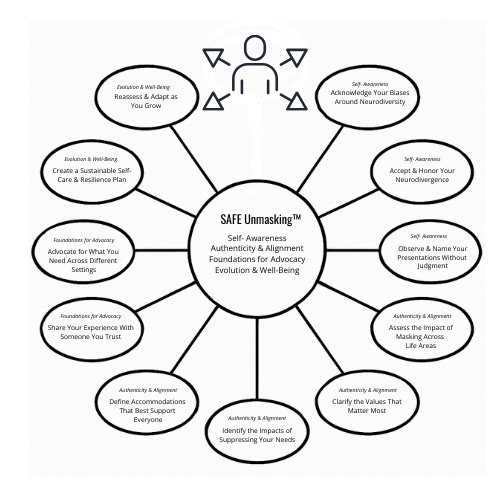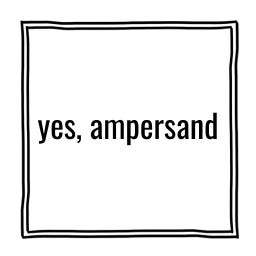Introducing SAFE Unmasking™ for Authentic Neurodivergence
Reimagining what it means to live authentically as neurodivergent
If you’ve recently discovered you’re autistic, ADHD, or otherwise neurodivergent, you might be wondering what to do with that knowledge.
Do you want a safe place to explore your identity without judgment?
Are you looking for guidance to help you unmask at your own pace while protecting your well-being?
Do you want practical tools for setting boundaries, communicating your needs, and building a life that feels more authentic?
If any of this resonates, SAFE Unmasking™ offers a framework to begin. It is designed to help you approach your neurodivergence with safety, clarity, and compassion, whether in journaling, personal reflection, therapy, counseling, or coaching. It is nonlinear and and was designed to meet you where you are. More below.
If you want to know a little about me or my professional background, that’s awesome. These things help build trust. Click the button below.
[Introducing SAFE Unmasking™ for Authentic Neurodivergence]
Where it All Began
I got my autism diagnosis in August 2023, and my ADHD diagnosis came shortly afterward. I was 48. As I write this post, I’ve entered the third year of my “official” autistic experience. The truth is, it’s been a much longer process. In reality, I’ve been autistic with ADHD (AuDHD) all my life. The diagnoses only changed the perspective of my experience, not the experience itself. I sought out diagnostic services after I identified my traits and explored the criteria myself first. I was able to obtain a diagnosis because there is greater access to out-of-pocket autism services in Mexico and have the privilege of affording it. I know what it is like to discover my own neurodiversity. I advocate for those who do the same but are unable to find reasonably priced, timely diagnostic services where they live. Just because someone can’t obtain an autism diagnosis does not negate their right to be recognized or access care. This I feel strongly, yet is not the focus of this post. There are others that address this important theme.
My “journey” (am I the only person who finds this term overly cliché?) related to my neurodivergence began back in 2017 when I sought out talk therapy. I didn’t realize it, but I was in a space where I could finally address my natural traits and how they impacted my experiences in the world around me. I was open to the idea, barely, that I wasn’t always the root problem regarding my lifelong challenges. Delayed processing, demand avoidance, complex pattern recognition, rumination, executive function challenges — these all played a part, among other traits, in the labels that others gave to me that I had accepted. Instead of AuDHD, I was labeled as controlling, unfocused, dramatic, unreliable, and a know-it-all, among others. They say that when you aren’t labeled as neurodivergent, you’re likely labeled in other, mostly negative ways. When I started therapy, I was ready to talk about how all this made me feel.
During one session, I identified that I felt I was “performing” a lot, and it depleted my energy and caused conflict. During another session, I felt I had prioritized others’ needs over my own and had had a difficult time identifying what I actually wanted or needed. Later, I recognized that my boundaries were unhealthy and that it was okay to move them to honor my autonomy. I acknowledged that my natural brain processing was atypical. I identified conflicts based on these differences and learned I could advocate for myself when others didn’t. I was unmasking and didn’t realize it. I was identifying that my brain was different, and that was okay. I was learning how to share this with others and prioritize my own wellbeing. This all came years before my diagnosis.
To check out a list of my series with descriptions and links, click below.
On My Way
In 2022 it came to me that something was going on; that I wasn’t innately the root of my problems. For years, I accepted the idea that I was choosing to behave in a way that caused conflict and that it was up to me to change. The fact that I couldn’t wasn’t a failure. I was working against my own nature. I began to seek out some answers to the challenges I experienced throughout my life. My therapist, also a psychiatrist, went along with my hunch. We discussed various disorders related to my traits. One day he identified some of my traits as schizoid. As usual, I went into full research mode after my session and stumbled upon the website of Dr. Megan Anna Neff, Neurodivergent Insights. There, she shared a post about how she, too, felt she had schizoid tendencies, and it turned out that she was actually autistic. A graphic identified where the two shared traits and where they differed. When I looked at the traits on the “autism” side of the graphic, I was floored. I shared many of them. This was when autism became one of my special interests, like many other late-identified autistics. I couldn’t stop researching. I found the Diagnostic and Statistical Manual of Mental Disorders, Fifth Edition, and looked up the criteria for autism. I was amazed to see that I met the standards. During the summer of 2023, I went through the multiple appointments and evaluations involved in a formal diagnosis. One day in August, I received the piece of paper that confirmed my initial hypothesis was correct.
You might think that day was the start of my autistic self-exploration. The reality was that I had begun the process several years before without realizing it. This allowed me to identify the work I had done up to that point and figure out what was next. The rest of 2023 and the beginning of 2024 involved sharing my diagnosis and processing how others reacted. One year after my diagnosis, in August 2024, I realized that most people didn’t know what to do with this new information and, frankly, hoped it wouldn’t change anything. Meanwhile, I was changing, and others were finding it difficult to adjust. Luckily my husband, a psychologist and medical anthropologist, was supportive and found my journey as interesting as I did. It wasn’t smooth by any means, but he was able to manage the nonlinear, stop-and-go nature of my process. He didn’t always understand, but he was always respectful and caring.
I decided to write a document to share with those I cared about that offered information about my autistic traits, autism in general, and how they can connect with the new me. I thought it was amazingly thorough and thoughtful. It was over 15 pages. I sent it out, and few responded. I took that personally. The feedback from the few who offered it was that it was (too) long and they would do their best. They were kind and caring, but not engaging with me about my experiences as I expected. In retrospect, I offered them what we conventionally call a neurodivergent “info-dump” in written form. This isn’t everyone’s preferred communication or learning method. I realize this now.
It was late 2024 when I realized that, despite challenges with my wider community relating to my diagnosis, that my husband, my therapist, and a few of my close friends and family were dialed into my experiences and acknowledging them. They were willing to support me as I chose to live more authentically. They let me know they loved me no matter what and wanted to be a part of my new way of being. That new way of being had a name: unmasking.
New around here? Click the button below to get your bearings.
The Unmasking Focus
Masking, in short, is a process where someone hides their natural traits from others for safety or comfort. I have a great post outlining this called “Everybody Masks” if you want to learn more about how masking isn’t just a neurodivergent thing. Often, neurodivergent people who were not screened and who have not self-identified will unconsciously mask their traits to make it in the world around them. There’s a video about the “Lost Generation” of undiagnosed Boomer, Gen X, and Millennial autistics by Dr. Neff that you can check out if it interests you. Masking isn’t inherently negative. It is when it causes harm. Often the harm comes in the form of the stress of “keeping up appearances” on the body and mind. My anxiety, disordered eating, depression, heart issues (among others) all tie into the stress related to masking. That’s where unmasking comes in — the acknowledgement of natural traits and the needs and boundaries based on them.
Once I realized I was in the process of unmasking, things went into high gear. My pattern recognition traits came in handy as I started to identify what I had already done up to that point and what I could do next. I started to group these forms of unmasking together to better “manage” my development in this area. This is where the SAFE Unmasking™ processes came to be. Although they were identified in 2024, I have been developing, implementing, and evaluating them since 2017.
I isolated eleven ways I was unmasking and grouped them together into categories. With the help of AI, I identified the best way to group them into an acronym. There were several options I could choose from. I chose “SAFE” because the categories matched my experiences and because a significant component of this process has been built on my personal safety and care. Unmasking isn’t something that happens in a vacuum. It happens within the construct of a person’s lived experience. It has to feel safe, or it isn’t useful. It also has to be nonlinear to be effective. Unmasking, for me, has been a two steps forward, one-and-a-half steps back kind of journey. There are starts and stops. There’s no single “starting point” or “endpoint.” I realized that if this was something I wanted to share with others in a meaningful way, it had to be flexible and adaptable.
The interesting thing about this whole story is that I was in the process of completing a second master’s degree in counseling with the goal of providing services remotely from my home office. I am still in that process. It is slow-going, mostly due to tuition costs. After I introduced SAFE Unmasking™ to my husband, he suggested I share it more widely and turn it into a business. That’s where coaching came into play. I come from the world of training and development and have a master’s degree in human performance improvement. Coaching has been a significant component of my career over the last twenty years. Why stop now? This is why I’ve spent the last year developing my coaching practice based on the Acceptance and Commitment framework (see my post about that here) and SAFE Unmasking™ processes. My goal is to work as a coach and then transition to also providing counseling services when I complete my degree. To compliment this I earned a Certified Autism Specialist designation based on my years of experience working with autistic adults, completed two coaching certifications, and have met the standards for an International Coaching Federation membership.
Introducing SAFE Unmasking™
Today, I’d like to share an overview of SAFE Unmasking™ — what it stands for and what the processes can do. I’ll share some reflexive questions you can ask yourself that align with the processes as well, to see if they resonate with you. This is an overview/introduction. I plan to go into detail on each of the eleven processes in future posts. In the meantime, take a look and let me know if you think these processes might benefit you or someone you care about. It is important to note that these processes leverage an intersectional approach where all aspects of an individuals’s lived experiences are considered and valued. Read more about the importance of intersectionality in unmasking here.
Each letter in the SAFE Unmasking™ acronym stands for a meaningful aspect of neurodivergent unmasking.
S is for Self-Awareness: noticing your patterns, strengths, differences, and how you’ve adapted to fit in.
A is for Authenticity & Alignment: clarifying what matters to you, where you feel safe, and how you want to show up.
F is for Foundations for Advocacy: identifying your needs, practicing self-expression, and building supportive relationships.
E is for Evolution & Well-Being: creating routines, monitoring growth, and adjusting at your own pace.
The Processes
Each of the letters of the acronym represents a set of processes that encourage authentic neurodivergent expression for increased wellbeing; there are eleven of them in total. I’ll share them in their entirety in a later post. Below you’ll find high-level examples of the work one might do in each area and some reflexive questions that correspond to them. These aren’t exhaustive; they’re merely an overview of work that one can do within the model. Remember, SAFE Unmasking™ is a nonlinear process. There is no defined starting or end point. Each person’s use of the processes can be personalized to meet their needs.
Self-Awareness: Understanding yourself as a neurodivergent adult.
Recognize patterns and coping strategies
“What adaptations have I been making to navigate the world?”
“Which behaviors help me survive, and which drain me?”
Notice triggers and stressors
“What situations feel overwhelming or uncomfortable?”
“How do I respond when I feel overstimulated?”
Identify strengths, traits, and needs
“What differences feel most natural or energizing for me?”
“Which needs have I been ignoring?”
Authenticity & Alignment: Exploring what feels true.
Define core values
“What matters most to me in work, relationships, or daily life?”
“Where do my current routines or relationships feel misaligned?”
Assess safety and boundaries
“Where do I feel comfortable showing more of myself?”
“What boundaries help me feel secure?”
Experiment gently
“What’s one small way I can try expressing a need, preference, or trait authentically?”
“How did that feel afterward?”
Foundations for Advocacy: Building support and communication skills.
Practice self-expression
“Who feels safe enough for me to share my neurodivergence?”
“What do I want others to understand about me?”
Set healthy boundaries
“Which limits are important in protecting my energy?”
“Which boundaries feel most urgent to assert?”
Build supportive connections
“Who consistently affirms me as I am?”
“Who could I reach out to for guidance or accountability?”
Evolution & Well-Being: Creating sustainable growth.
Develop self-care routines
“What activities restore my energy or calm my nervous system?”
“Which routines are non-negotiable for my well-being?”
Track growth and changes
“What shifts have I noticed since learning I’m neurodivergent?”
“What feels different in my relationships or daily life?”
Practice flexibility
“How can I let my understanding of myself evolve without pressure?”
“Where can I experiment and adjust at my own pace?”
Free unmasking resources on my website
If this post spoke to you, I invite you to visit my website where you can download free, practical guides designed to support your unmasking journey and deepen your understanding of neurodivergence. These resources are created with care for late-identified neurodivergent adults, their allies, and anyone seeking compassionate tools to live more authentically.
The Benefits
The benefits of SAFE Unmasking™ are as varied as the experiences of the people who use it. For me, it has helped to recover from burnout, reduce the negative impacts of meltdowns, reduce anxiety, and improve a sense of self-worth, among other things. Will it do that for everyone? That depends on one’s needs and situation. One way I look at unmasking, apart from the processes I’ve shared here, is that it helps you to feel better in little “chunks.” There’s a mindset for some in mental health and wellness that it’s not a matter of being 100% “cured.” It’s a matter of small improvements in various parts of your experience that add up to feeling better; three percent less stressed at home, four percent less anxious at work, six percent less overwhelmed in social situations. These don’t seem like monumental improvements, but they add up to feeling increased wellbeing overall. Small wins can improve a person’s daily experience. Unmasking follows the same model. Small improvements in various areas of one’s life can make a measurable impact. It all adds up. Living with less anxiety, depression, stress, obligation, conflict, etc., can lead to a longer and more rewarding life. Everybody deserves that.
SAFE Unmasking™ gives you a structure to explore, reflect, and take small steps toward authenticity, connection, and well-being at your own pace. Try to use the questions above for journaling, therapy, coaching, or group work and see what works for you. Pick what resonates, leave what doesn’t, and know that growth is nonlinear. If you want guidance in navigating the emotional, social, and practical steps of this journey, coaching provides a safe environment to experiment, reflect, and build a life aligned with who you truly are. Reach out to me with any questions through the comment section below or via email (mark@markdurgee.com). Let me know if you feel SAFE Unmasking™ might help you or someone you care about. Also, let me know if you feel I’ve missed something important. I’m always ready to learn from others and their experiences.





